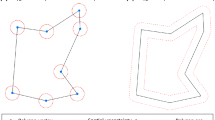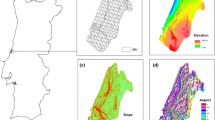Abstract
It is reasonable to assume that there is a relationship between the spatial distribution of forest fuels and fire hazards. Therefore, if fire risk is to be included into numerical forest planning, the spatial distribution of risky and non-risky forest stands should be taken into account. The present study combines a stand-level fire risk model and landscape level optimization to solve forest planning problems in which the fire risk plays an important role. The key point of the method was to calculate forest level fire resistance metrics from stand level indices and use these metrics as objective variables in numerical optimization. This study shows that maximizing different landscape metrics produces very different landscape configurations with respect to the spatial arrangement of resistant and risky stands. The landscapes obtained by maximizing different metrics were tested with a fire spread simulator. These tests suggested that the mean fire resistance of the landscape, which is a non-spatial metric, is the most important factor affecting the burned area. However, spatial landscape metrics that decrease the continuity of fire resistance in the landscape can significantly improve the fire resistance of the landscape when used as additional objective variables.
Similar content being viewed by others
References
J.K. Agee B. Bahro M.A. Finney P.N. Omi D.B. Sapsis C.N. Skinner J.W. Wagtendonk Particlevan C.P. Weatherspoon (2000) ArticleTitleThe use of shaded fuelbreaks in landscape fire management Forest Ecol. Manage. 127 55–66 Occurrence Handle10.1016/S0378-1127(99)00116-4
J. Borges H. Hoganson A. Falçao (2002) Heuristics in multi-objective forest management T. Pukkala (Eds) Multi-Objective Forest Planning Kluwer Academic Publishers Netherlands 119–151
M.A. Finney (2001) ArticleTitleDesign of regular landscape fuel treatment patterns for modifying fire growth and behavior Forest Sci. 47 IssueID2 219–228
Finney M.A. and Cohen J.D. 2003. Expectation and evaluation of fuel management objectives. In: USDA Forest Service Proceedings, RMRS-P 29, pp. 353–366.
F. Glover M. Laguna (1993) Tabu search C.R. Reeves (Eds) Modern Heuristic Techniques for Combinatorial Problems John Wiley and Sons, Inc. New York 70–150
González J.-R., Palahí M., Trasobares A. and Pukkala T. 2005. A fire probability model for forest stands in CataloniaManuscript.
T. Heinonen T. Pukkala (2004) ArticleTitleA comparison of one- and two-compartment neighbourhoods in heuristic search with spatial forest management goals Silva Fenn. 38 IssueID3 319–332
K. Hirsch V. Kafka C. Tymstra R. McAlpine B. Hawkes H. Stegeehuis S. Quintillo S. Gauthier K. Peck (2001) ArticleTitleFIRE-smart forest management: a pragmatic approach to sustainable forest management in FIRE-dominated ecosystems Forest. Chron. 77 IssueID2 357–363
InstitutionalAuthorNameICONA (1993) Segundo Inventario Forestal Nacional (1986–1995) Cataluña: Lleida MAPA Madrid
J.E. Keeley C.J. Fotheringham (2001) ArticleTitleHistory and management of crown-fire ecosystems: a summary and response Conserv. Biol. 15 IssueID6 1561–1567 Occurrence Handle10.1046/j.1523-1739.2001.t01-1-00186.x
C. Loehle (2004) ArticleTitleApplying landscape principles to FIRE hazard reduction Forest Ecol. Manage. 198 261–267 Occurrence Handle10.1016/j.foreco.2004.04.010
McGarigal K. and Marks B.J. 1995. FRAGSTATS: Spatial Pattern Analysis Program for Quantifying Landscape Structure. USDA Forest Service, PNW, General Technical Report 351, 122 pp.
R.A. Minnich (2001) ArticleTitleAn integrated model of two fire regimes Conserv. Biol. 15 IssueID6 1549–1553 Occurrence Handle10.1046/j.1523-1739.2001.01067.x
M. Palahí (2002) Modelling Stand Development and Optimising the Management of Even-Aged Scots Pine Forests in North-East Spain University of Joensuu JoensuuFinland 58 + App
M. Palahí T. Pukkala (2003) ArticleTitleOptimising the management of Scots pine (Pinus sylvestris L.) stands in Spain based on individual-tree models Ann. Forest Sci. 60 105–114 Occurrence Handle10.1051/forest:2003002
Palahí M., Pukkala T., Pascual L. and Trasobares A. 2004. Examining alternative landscape metrics in ecological forest landscape planning: a case for capercaillie in Catalonia. Investigaciones Agrarias: Sistemas de Recursos Forestales 13(3): 527–538
T. Pukkala (2002) Introduction to multi-objective forest planning T. Pukkala (Eds) Multi-Objective Forest Planning Kluwer Academic Publishers Netherlands 1–19
Pukkala T. 2003. MONTECalculation and Planning Program for Even-Aged and Uneven-Aged Forests of Catalonia. User's guide. Joensuu2003.
T. Pukkala J. Kangas (1993) ArticleTitleA heuristic optimization method for forest planning and decision making Scand. J.␣Forest Res. 8 560–570
C.R. Reeves (Eds) (1993) Modern Heuristic Techniques for Combinatorial Problems EditionNumber1 John Wiley and Sons, Inc. New York 320
F.P. Schoenberg R. Peng Z. Huang P. Rundel (2003) ArticleTitleDetection of non-linearities in the dependence of burn area on fuel age and climatic variables Int. J. Wildland Fire 12 1–6 Occurrence Handle10.1071/WF02053
D. Tábara (1996) La percepció dels problemes del medi ambient Beta Editorial Barcelona
A. Trasobares T. Pukkala J. Miina (2004a) ArticleTitleGrowth and yield model for uneven-aged mixtures of Pinus sylvestris L. and Pinus nigra Arn. in Catalonianorth-east Spain Ann. Forest Sci. 61 IssueID1 9–25 Occurrence Handle10.1051/forest:2003080
Trasobares A., Tomé M. and Miina J. 2004b. Growth and yield model for Pinus halepensis in Catalonianorth-east Spain. Forest Ecol. Manage. 203: 49–62.
R. Vélez (2002) ArticleTitleCauses of forest fires in the Mediterranean Basin EFI Proc. 45 35–42
Author information
Authors and Affiliations
Corresponding author
Rights and permissions
About this article
Cite this article
González, J.R., Palahí, M. & Pukkala, T. Integrating Fire Risk Considerations in Forest Management Planning in Spain – A Landscape Level Perspective. Landscape Ecol 20, 957–970 (2005). https://doi.org/10.1007/s10980-005-5388-8
Received:
Accepted:
Issue Date:
DOI: https://doi.org/10.1007/s10980-005-5388-8




